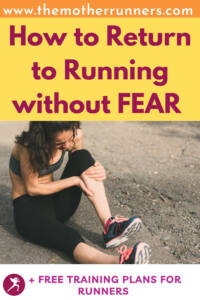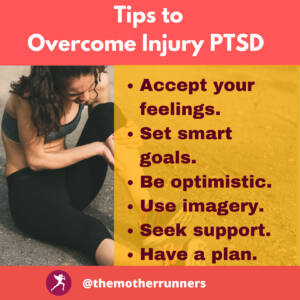From 2019 to 2022, I was in a running injury cycle. I tore my hamstring and soon after recovering from injury, I tore my plantar fascia. Now that I have returned to running, I have an immense fear of reinjury (aka injury paranoia).

I am aware of every little ache and pain (also called a “niggle” in runner speak) my body experiences. And every little twinge sends me close to a spiral for fear of injury.
Indeed, it is so hard to know in running what’s just your body adapting to the new training stress and what’s the start of a real-life sports injury. Minor aches and pains as you start running are normal, after all.

Related: PRP for a Torn Plantar Fascia
My experience with Fear of Reinjury & Injury PTSD
I have been told by my doctors, friends, and physical therapists that this hyperawareness of how my body feels is common after having a running injury. I’ve also witnessed it in my running friends and athletes.
Indeed, I started calling it “running injury PTSD” or “sports injury PTSD.” But wondered if it was actually a thing and if so, how can we cope with this fear?
It turns out having post-traumatic stress disorder (or PTSD) from an injury is, in fact, a thing. Having PTSD after a sports injury actually has a name, it’s called kinesiophobia which is fear of reinjury after a sports injury. Some people also called it “injury brain.”
Having a sports injury is incredibly common. In fact, according to the U.S. Centers for Disease Control and Prevention (CDC), 8.6 million sports- and recreation-related injuries happen every year. Running, as a high impact and repetitive exercise, is a sport that has a high rate of injury. And with that, comes a high rate of fear of getting hurt again.
Related: Lessons Learned from My Running Injury
So, now that we know this fear is real and has a name, what can we do about it?
I reviewed research and got with sports psychologist Dr. Haley Perlus on how to cope with sports injury PTSD, aka kinesiophobia or injury brain.
In this article, I’m going to cover:
- How a sports injury affects your mental health
- How to tell if you’re actually injured or dealing with fear of reinjury
- How to tell if you are suffering from injury PTSD, and
- Tips on how to cope with a fear of reinjury or injury PTSD
So, let’s get started.
How does a sports injury affect your mental health? How do injuries affect you mentally?
It is not uncommon to feel depressed, anxious or have PTSD following a sports injury, studies find.
Related: Expert Tips to Diagnose & Prevent Common Running Injuries
The psychological response to an injury can unmask underlying issues that activities such as running helped one cope with. After all, most of us runners know that running offers a host of mental health benefits.
Being injured can also offer a huge life change to runners. When running was your outlet, distraction, time for connection or stress relief, having that taken away for an undetermined period of time can be hard for anyone to deal with.
It is a large upheaval of the daily routine, a ritual that benefits both our bodies and minds, and it can lead to mental health struggles.
Related: 9 Steps to Return to Running After an Injury

There were some days when I was dealing with my never-ending hamstring injury that I didn’t feel like getting out of bed. I had so much tied up in my running—including my business, my dreams and goals, my social connection, and my identity—that not being able to do it and now knowing if I could ever do it again how I wanted—made it hard to function at times.
And then, when I returned, I was filled with fear that I would be faced again with injury and time off. I felt like I was broken or weak and that being “injured” or “injury-prone” was my new identity.
This psychological response to injury is also very common, I have found.
What are the reasons for having injury PTSD?
A runner or athlete may have PTSD after injury, or kinesiophobia, because they have a high level of anxiety due to the seriousness of their injury and the consequences of the injury itself.
Being injured can be an assault on your identity and source of joy and leave you feeling helpless and sad.
How can I tell if I’m actually injured or dealing with fear of reinjury?
When I returned to running this summer, I thankfully had friends and trained professionals assure me that every little pain wasn’t going to turn into another major injury.
I also interrogated many doctors and physical therapists for my site and the podcast I host, The Passionate Runner, to figure out how to determine what’s an injury and what’s in my head.
I am not a doctor or physical therapist but here are some touchpoints I hope help calm your nerves if you’re afraid of being reinjured running.
- Remember, your body will experience aches and pains as it gets stronger and adapts to running again. This is normal.
- Be on top of the little things to assure your body and mind are sound such as
-
- warming up
- running easy
- sleeping well
- eating well
- strength training
- doing mobility work
- wearing proper running shoes with not too much mileage
- wearing supportive shoes throughout the day
- increasing mileage gradually
- taking regular rest days
- and taking cutback weeks every few weeks.
- If you experience some pain, ice it, foam roll it, keep calm and run on extra easy. It should resolve in a few days.
- If the pain gets worse as you run or after you run above a pain level 3/10, take an extra day or so off until you feel better.
- If the pain becomes acute or persists, then call a physical therapist trained in helping runners for help. Always have a plan for when you may have a budding injury. Be okay with taking some extra time off.
Related: The Best Recovery Shoes for Runners
What are the symptoms of PTSD?
According to Dr. Perlus, there are many symptoms and signs of PTSD that can impact all aspects of your life. Below are some signs that you may be struggling with PTSD after your injury:
Related: When to Replace Your Running Shoes
Symptoms of Injury-related PTSD
- Flashbacks and nightmares about the injury event
- Psychological distress including:
- Hypervigilance – many activities (not just running) can be perceived as a threat to your safety
- Confusion and uncertainty (e.g. about whether you’ll be able to fully return to running the way you want)
- Irritability
- Difficulty concentrating
- Poor self-concept, esteem, and identity
- Isolation
- Avoidance of stimuli that are in some way related to the injury event
- sleep difficulties
What should you do if you have injury-related PTSD?
If you are experiencing the above symptoms, seek professional help from a sport psychologist and/or clinical psychologist. They will be able to use therapies such as trauma-focused cognitive behavioral therapy, stress management, cognitive processing therapy, and others to help you cope.
If you are like me who experienced an injury, got sad about it, and then had injury paranoia, time and the below strategies, can help you work through it.
How do I get over my fear of reinjury after having a running injury?
Below are tips to cope with injury PTSD and fear of reinjury from Dr. Perlus.
6 Coping Strategies for Injury PTSD and Injury Paranoia

Set wise goals.
Find out your current level of ability. This is not what you used to be able to do or what your long-term vision is for yourself. Visit with a doctor, running coach, physical therapist, etc. to assess your current level of ability.
Next, experiment with setting goals just below, at, or just above your current level of ability. These goals are to help you feel in control and confident, yet also still challenge you.
If you set goals too high that create anxiety, you are simply heightening your psychological distress (not to mention other consequences).
Related: 9 Mental Training Tips from Sports Psychologists
Use imagery.
A sport psychologist and clinical counselor will guide you through imagery where you revisit the injury event and create a more accurate appraisal of it, lessening the emotional and physiological responses.
However, on your own, you imagine yourself recovering from your injury and achieving the wise goals you set.
In sport psychology, we use healing imagery, symbolic imagery and mastery imagery to help build confidence and focus.
Be an optimistic thinker.
Each day, ask yourself: (1) what did I achieve today? And (2) what do I get to do tomorrow.
These two questions bring gratitude for your life.
Accept your feelings.
It’s okay to be sad, scared, angry, etc. Once we accept these unpleasant emotions, we can move forward with all the other coping techniques.
Ask for support.
In addition to seeking professional help, ask your family, friends, and community to support you.

Choose someone who can be your cheerleader. Choose someone else who can be your truth-teller. Choose another person to be your coach.
Ask people for support and, when they need you, step up and support them. Offering to help someone else gets you out of our personal anxiety and raises your energy for someone you care about.
When I was injured, I wanted to cut myself off from the running community—including abandoning The Mother Runners. I fought this urge and was so glad I did. Staying connected and cheering for others who could actually run helped me stay positive and feel fulfilled by running, even if I couldn’t do it (yet).
Make a plan.
This point comes from me. I worked with my physical therapist to have a return-to-run plan. This plan held me accountable for not doing too much or too little to test and strengthen my plantar fascia injury.
If I stressed it too much, I had a plan as to what to do: back off and see my PT. If I have niggles crop up now that I am fully healed, I have a plan: back off if the pain persists after several days or worsens when I run, and see my PT or neuromuscular massage therapist.
I choose to believe that these injuries have made me a stronger, smarter, and more gracious runner. Never again will I take the ability to run for granted. And, I won’t let my past injury or fear of an injury hold me back from enjoying the gift of running.
If you want guidance with your training, including returning to running after injury, check out my run coaching services. Also, be sure to check out my free training plans:
- Postpartum Training Plan
- After a Break Training Plan
- 5k Training Plans
- 10k Training Plans
- Half Marathon Training Plans
- Marathon Training Plans
- Strength Training Plan

Thank you for this!!! I needed this one. Struggled with an inner groin and high hamstring tendon/ligament issue. Now I’m sore sometimes but more muscle related. So trying to shift my mindset to knowing it’s my body getting stronger not injured again. ❤️